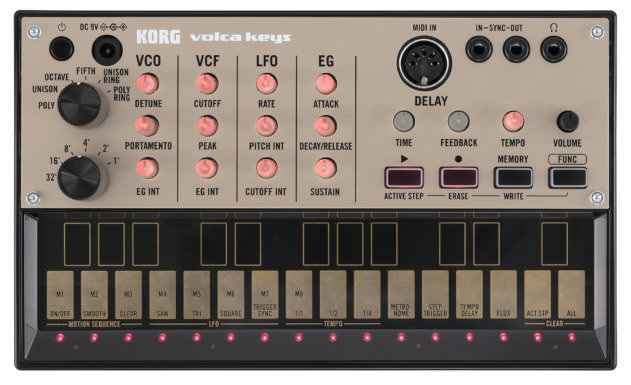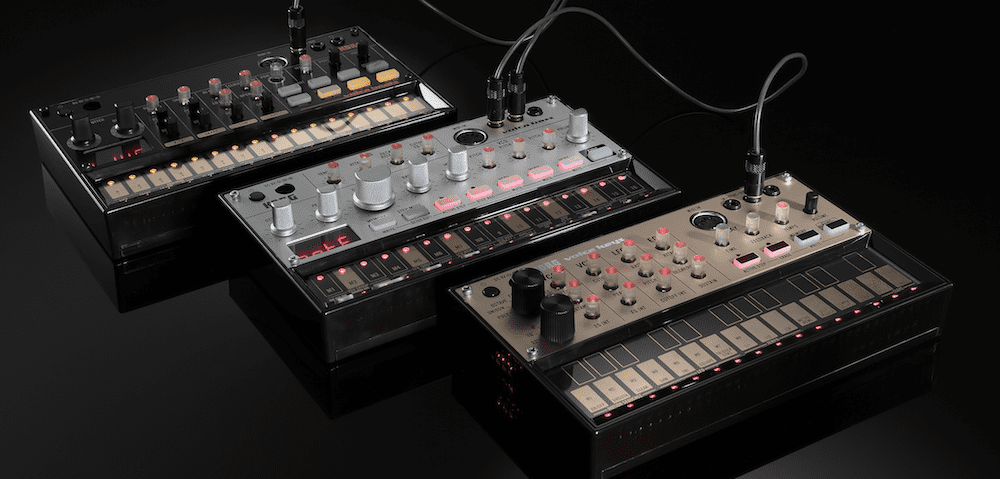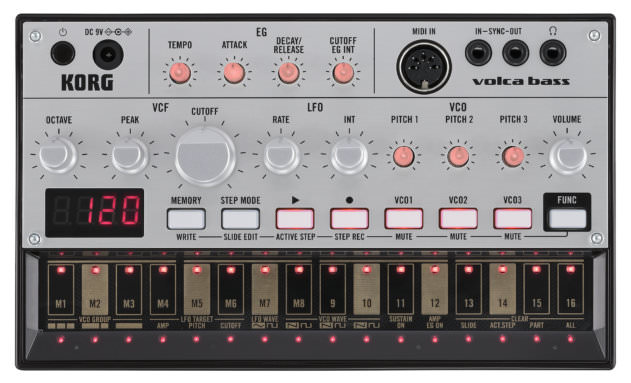Volca Bass
All three Volcas use an intuitive programming and editing system. The Function key on the main panel allows settings to be changed by tapping notes on the ribbon. In the case of the Bass, for example, holding down the Function key then pressing the M8, 9 and 10 keys toggles the three VCOs back and forth between sawtooth and square waves. The Function key also provides access to secondary functions on some of the front panel buttons. Holding down Function while pressing the record button, for instance, enables step recording mode rather than the standard real-time mode. Holding down Function while pressing any of the three VCO buttons mutes the respective oscillator.
The way those three oscillators interact is, in itself, an interesting feature. On the surface, you’d be forgiven for assuming the Bass is a regular monophonic synth with three oscillators, but dig a little deeper and you’ll see that M1, M2 and M3 select three different VCO Group modes. These allow the oscillators to be sequenced either together as one group, individually as three separate parts, or as a pair of two and a separate single oscillator. These oscillators or groups can then be sequenced completely separately. All other controls – i.e. the filter, the envelope and the LFO – affect all three oscillators regardless of grouping, but this still means you can build up multi-part patterns with harmony or counter-melodies.
Each oscillator can be detuned in 2 cent increments from -96 to +96 cents or in whole semitone increments from -12 to +12. (Note that the position of the dedicated Octave knob only affects the notes played by the keyboard and recorded into the sequencer, not the pitch of the oscillators during playback from the sequencer. If you’ve recorded a pattern then want to transpose it up or down, you’re limited to the range of the individual VCO pitch controls.)
Shift keys and multiple functions per button are widely vilified, but in this case it’s really quite intuitive. Unlike, say, the TB-303 (we just can’t avoid the comparison), you’ll have no difficulty using the Bass – or the other two Volcas – without bothering to read the manual. It’s well worth having a flick through the clear, well-written manuals to discover the intricacies of some of the functions, but these are truly pick-up-and-play devices with very little learning curve. As with all of the Volcas, there’s a lot more to the Bass than there might first seem – note slide; a simple envelope which can be assigned to amplitude, filter cutoff or both; eight pattern memory slots – but all features are clear and simple in operation. The range of sounds and effects which can be drawn out of the Bass is impressive for a such a simple, cheap unit.
If you were hoping that the Volca Bass might be a cheap 303 clone, you could be disappointed. It isn’t. If the authentic sound of the 303 is your top priority, you’re better off with a x0xb0x or Cyclone TT-303. But that’s not the point. The Bass has its own sonic character, plus a few interesting features which set it apart from the 303: notably the three oscillators and the LFO.
The only major weakness is that the ribbon controller keyboard strip is arranged chromatically, plus it’s also a ‘reverse’ keyboard: sharps and flats in white, naturals in black. There’s a bit of heritage there – Korg offered a reverse keyboard option on the Poly800 – but having the notes in the ‘wrong’ colours on a continuous, chromatic ribbon controller just makes it confusing to figure out which notes you’re playing. Other than that, we’d struggle to find any serious criticisms of the Bass. No external audio input to the filter? We can live with that for now, especially as the DIY community will be sniffing round the Volcas for modding potential as soon as they can get their hands on them.
Volca Keys
The three-voice polyphonic synth engine of the Keys is probably the least obviously suited to the step sequencer-based groovebox format, but in practice it works surprisingly well, not least because the Flux option allows sequences to run in unquantised mode without being tied to the 16 steps of the sequencer. Given that the sequencer will run all the way down to 10 bpm and can then be further stepped down to half or quarter tempo setting for longer sequences, that gives plenty of potential to create complex polyphonic chord sequences or lead parts.
 Korg have simplified the oscillator controls of the Keys down to just a couple of knobs. The main rotary switch offers six self-explanatory options with a range of monophonic and polyphonic sounds: Poly, Unison, Octave, Fifth, Unison Ring (ring modulation) and Poly Ring.
Korg have simplified the oscillator controls of the Keys down to just a couple of knobs. The main rotary switch offers six self-explanatory options with a range of monophonic and polyphonic sounds: Poly, Unison, Octave, Fifth, Unison Ring (ring modulation) and Poly Ring.
The small detune knob alongside is particularly useful in the four monophonic modes, although potentially also interesting for atonal effects in the polyphonic modes. The most obvious use for a polyphonic synth is chords and pads, but in the monophonic modes the Keys will also do a pretty decent bass sound or a thick lead. Unlike the Bass, the Keys has a proper, piano-style keyboard with the black keys positioned above the white ones rather than all evenly spaced in a straight line. As a result, it’s much easier to play than the Bass.
The point where the Keys really shines is when you begin to explore its motion sequencing options, inherited from the Electribes. When activated, any knob movements you make will be recorded as ‘motion sequences’ (automation, in other words). The implementation is versatile and surprisingly intuitive. Almost every rotary pot can be automated, with the exceptions of resonance, the master tempo control and the master volume. Motion sequence recording helpfully latches on for just one bar, while a smoothing option makes it easier to create clean looping curves of automation. Motion sequence playback can be toggled on and off easily, while any adjustment of parameters during playback will temporarily override the automation until the controls are released. Here we start with a simple sequence, filter manually, then activate some pre-recorded motion sequences to add movement to six or seven different parameters simultanously:
The outputs of the Volcas are all just about clean enough for serious use, if not the cleanest you’ll ever hear. It’s worth noting too that the pitch stability of both the Bass and Keys is impressive. The two synth-based Volcas run an auto-tuning routine in the background whenever they’re idle for over ten seconds, meaning that they’re constantly compensating for changes in ambient temperature in the background whenever they’re not in use. As with the Bass, it’s remarkable how much can be squeezed out of what initially appears to be a very simple synth architecture. Don’t fall into the trap of thinking just because these are plastic units with tiny knobs that they’re not also serious synths. In fact, that same story applied to a few of Korg’s other products in the past; plenty of people didn’t take things like the Electribes or KaossPads seriously until they heard how good they sounded.
On the surface, there are sure to be plenty of people who dismiss these small, cheap, plasticky units as toys. But underneath there’s a lot to get excited about. It’s also worth considering the potential of the Bass and Keys when controlled via MIDI: these are surprisingly powerful synths which are limited to some extent when controlled by the built-in sequencer or ribbon controller. Hook up a proper MIDI keyboard or sequence them from your DAW and you can really take advantage of the sound design options which, despite the price and appearance of the Volcas, would give plenty of much more expensive analogue synths a good run for their money.


09.14 AM
Check that crazy demo of the Korg Volca Beats
http://youtu.be/tz2cwESyzeI